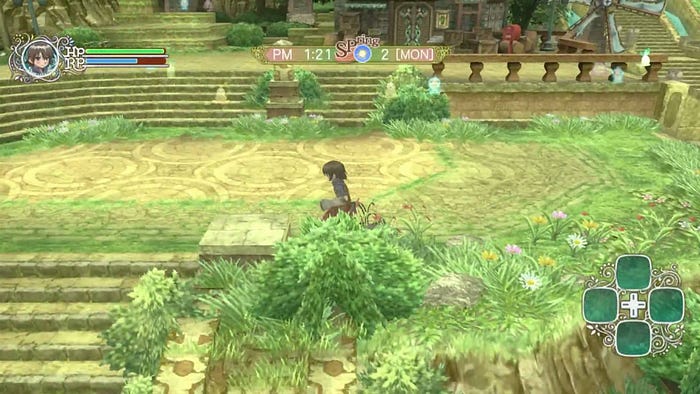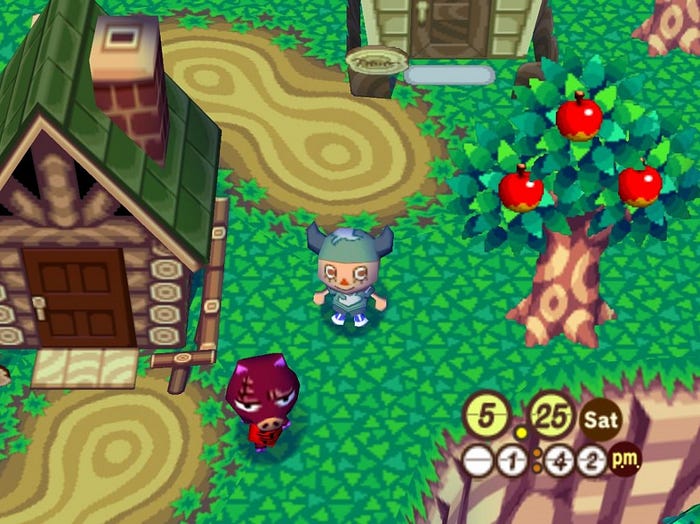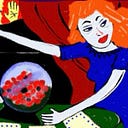Lay of the Land - Agriculture, Game Design, and Inhabitation in Farming Games and Life Sims

I’ve been thinking about corn. I squatted at a farm for a summer, and I was sandwiched between fields of soy and fields of corn. Despite that intimacy, it would be inaccurate to say I can tell them apart when first planted. But the height difference is palpable come harvest, the stalks of corn raised much higher, the waves of fruits overtaking the land. I’ve grown up around cornfields and farmland. For more than half of my life I’ve lived in an area split between agriculture and fishing. The population density is low; across the 277 square miles of land, there is, on a good year, just shy of 21,000 people split across three towns and a few villages. In spite of the abundance of (Monsanto-desecrated) farmland, it is, paradoxically, a food desert; it takes about 10 minutes from my family home to drive into town to the nearest grocery store, at a distance of a mile a minute. This is true of many of the local neighborhoods and villages. My postal code is not for my town, but for that same 10 minutes out community. It’s podunk to some; pastoral to others.
In thinking about corn, what we grow, how we grow it, I have been thinking more about one of my favorite game series. Story of Seasons, as it is known outside of domestic markets, was once known as Harvest Moon, but the two are no longer one and the same. Marvelous Entertainment is the current Japanese developer and publisher of Bokujō Monogatari, literally “The Farm Story,” but previously the games were localized and published abroad primarily by Natsume, who gave them the now instantly recognizable title of Harvest Moon. In 2014, Marvelous decided to instead have their US branch, XSEED, take over the publication of the franchise. Natsume maintained the rights to the name Harvest Moon, but lost the ability to publish these Bokujō Monogatari titles. Marvelous, meanwhile, remained sole owners of Bokujō Monogatari, but they needed a new guise under which to ship it here and abroad. The title would become Story of Seasons.

I want to outline these titling and localization hijinks to emphasize a few things. For starters, this is a series with history. Its own harvests have been steady, regular, if, at times, not worth the effort. The original Bokujō Monogatari was released in ’96 for the SNES, and since then, there have been more than 40 games, with 29 mainline entries and 14 spin-off games. Fan favorites for the mainline include Harvest Moon 64, which had some of the more emotive character beats for the series, and Friends of Mineral Town, re-released this year under the Story of Seasons banner with a faithful 3D remake of the original GBA game. Notably, this revamp introduced same-gender marriages that, at least in localization, have a lovely directness to them that many games with same gender end states trade for ambiguity. Otherwise, though, the lay of the land remains the same. The storefronts and neighboring homes are where they were 17 years ago.
Secondly, there has been a sort of dual identity crisis developed as a result of this schism. Natsume’s Harvest Moon, now no longer a game under the Bokujō Monogatari banner, has become a series without direction; yeah, sure, they farm, but 2019’s Harvest Moon: Mad Dash replaces the familiarizable and recognizable maps and non-player character scheduling and calendar seasons with levels and a pace more hoping to emulate Overcooked than a game about farming should ever. And 2017’s Light of Hope, while more faithful to the series legacy, was received rather lukewarmly, a game just to tide over whatever gap between Story of Seasons releases (and with a pretty unappealing art style, subjectively). Homestory Town, one of their first releases with that title in their mitts but without Marvelous’s blessing, similarly deemphasized many common elements, instead doing Recettear without the charming writing or sense of character, but doubling down on the quote below.

Those Story of Seasons/Bokujō Monogatari releases too have seen more tepid reception as of late; while this years Friends of Mineral Town has been well regarded by fans, the critical reception has been warm but muted, and this has been the case across the various iterative releases and collaborations. They’re never quite poorly reviewed, per say; but the impact is soft and, for such a storied history, the series hasn’t modernized as gracefully as one might have expected.
Of course, this primer can’t be all I have to say; you have, by all rights, probably heard of these games in some iteration. And if you haven’t, well, you know what it has influenced. Stardew Valley, developed largely singularly as a passion project of Eric Barone, known as ConcernedApe, is easily the biggest and most successful. Ported to eight systems in addition to its home Windows client, Stardew Valley has, to underplay it, sold very well. Across all platforms there have been a total of ten million sales. Barone is presumably a homeowner now, but that statistical and numerical success is fascinating in the context of its themes; Stardew Valley, more explicitly than any Bokujō Monogatari, presents its agricultural vibes as an escape from the humdrum machinations of capital. You escape your deskjob at Amazon/Coca-Cola, and take over your granddad’s farm, his dying wish that you revitalize it. The last part of this framing is genre-typified; there’s quite often a dead granddad with a rundown farm. It’s borderline Dickensian in that sense.
Barone’s success is a nice story, and I think the scope and continued expansion of content in his game is commendable (though, Lord, I hope the man has stopped his “self-imposed crunch”). But there is something about Stardew Valley, which I have admittedly had an alright time with and have played for some hours (especially in the long stretch before any Bokujō Monogatari games were released for PC properly) that feels hollow. Some of it is the writing, I think; very few games under or related to the Bokujō Monogatari can be said to have “great” writing but they are charming in their simplistic archetypes and the localizations have generally been quite proficient and personal. Stardew Valley has what should be emotional beats but little depth or personality in this part of itself. It’s not a death knell though. Barone is a designer first, evidently, and that’s fine. What I think makes the foundation of the game so weak to me, though, is the agriculture itself.

Now, it should be said upfront that I am not a numbers girl. I see algebra textbooks and cower. So the primary engine of Stardew Valley being “numbers go up” is cause for disconnect. In spite of its “return to nature” premise, the game, more like Factorio than any Bokujō Monogatari game, is about building up your farm in pursuit of automation and maximum profits. All systems are built towards this; even the town center project that provides the narrative for the first two years in game functions as a reason to continue to farm. You expand your home; you buy your partner fancy gifts; you divorce your partner and erase their memory and marry them again; maybe you mod the game to make your livestock resemble Pokémon, or replace a few of the art assets for characters because there are a total of two non-white characters and maybe you’d like some variety and representation; but beneath this all, you farm, you build intricate, automated systems that till and water and irrigate and terraform and expand. A Stardew Valley player at high level play has mastered their land in such a way that they need not actually farm, really. Junimos, cute mascot sprites, do the harvesting for you even, once you buy a hut for them.
Additionally, Stardew Valley has combat; this combat is a rarity for the genre (but not an exclusive claim; more on that later) and one that provides more day-to-day activities beyond the fishing, farming, foraging triangle in which this would otherwise sit. You descend the ladder down mines and rend; you rend from the earth with your pickaxe and hoe, like in some entries in Bokujō Monogatari, but from there you go full Doom Guy, really, ripping and tearing as long as your stamina will let you. In reality, the combat is, frankly, boring. It is bare minimum hack and slash. It is another means of resource generation. It is another thing to master and then ignore.
Mastery is at the heart of Stardew Valley, and really, the means for my disconnect. You are manifesting destiny all over this land, your gentry grandfather has bequeathed to you, for no purpose beyond extraction. The story and gameplay are dissonant between one another: one purports the importance of nature, the back to our roots living of this small town (nearly) disconnected from the impurities of modern living (emphasized in JojaMart, the aforementioned Coca-Cola/Amazon hybrid); the other end of the deal says once that whole story thing is done and good, come play longer to see how efficient, how well designed, how profitable you can make this land. There is a disconnect between the selves the game holds, and between myself and it.
Despite their ostensible similarities though, Bokujō Monogatari does not have this sense of mismatched desires. The principles behind the design are wholly different; there is, of course, the tending of the land, the animal husbandry and rearing, the little romances with townspeople, and the attempt at building a small community of which you are a part. But Bokujō Monogatari resists mastery in this way; you raise skills, yes, but you can never automate. Weather in Harvest Moon remains flexible and potentially devastating, but it prevents your fields from staticity; Stardew Valley gives you lightening rods. There are no sprinkler systems or Junimos in Harvest Moon; in some games, you can befriend local spirits and sprites to assist in these chores, or raise animals to help, but this is always an investment of nurturing and relationality. Communal assistance requires being part of the community. And so on.
Rune Factory, the spin-off series of Bokujō Monogatari, adds combat into the dynamics of the land, but here, too, it takes on a gentle sensibility; you can’t kill monsters in Rune Factory, unlike in Stardew Valley. Instead, each game takes time to explain your farming equipment and weaponry are enchanted with spells that allow you to return the monsters to their homeworld, the Forest of Beginnings unharmed. Self-contradictorily non-violent combat. It’s a small thing. It changes little systemically. But its implications are great, and they’re not relegated to flavor text: why monsters crossover is sometimes a question of plot significance; monsters take the place of farm animals, and in fact can become friends and helpers with nurturing and care; in Rune Factory 3, you yourself have the ability to transform into one, which is part and parcel to the mystery in 3. Rune Factory resists not just Stardew Valley’s crass context, but even those of a game like Monster Hunter, whose most recent iteration saw several pieces written in response to its own brand of settler-colonialist violence contextualized through violence against indigenous fauna. You are not asked to master the land. You are asked to steward.

Stewardship is an even greater part of Rune Factory Frontier (my favorite game in the franchise) at a systemic level. Frontier has a much-maligned system that sees you having to maintain and balance the ecosystem of not just your farm but your entire community, adjusting where runeys, little natural spirits, are placed and allowing them to spawn, reproduce, and comfortably ebb and flow. Your own harvesting of crops is tied to it as well; if your farmland has too few runeys, the speed of growth is diminished greatly; but if you take from other places without allowing them to blossom themselves, they’ll wither, and you will lose them even on your own farm with little way to replenish. It is a remarkably delicate system, one that is often maligned for that delicacy, but it is such a beautiful microcosm of this difference in sensibility. Frontier asks you to consider the land holistically. You cannot master it. You have to balance your place within it. Any mastery comes internally; learning systems, considering balance, improving skills, learning schedules. You become inured to the ebb and flow of the systems and game space. It’s evocative in ways few games are.

This same tension exists in Nintendo’s Animal Crossing series. New Horizon is almost inarguably the biggest game of 2020, and I certainly played it. The systems of decoration and design have never been smoother. In most ways, it is the most user-friendly Animal Crossing has ever been, and for some, the most customizable, with the terraforming features being a bit of a hassle but nonetheless allowing for maximum customization of your play experience, your island. But that possession, and desire to make it one’s own, is maybe why I don’t connect with it as I once did. Many have brought up the linkage between New Horizon and gamified systems of settler-colonialism, but I think, too, that this trend of dicey, player-centered design began earlier in New Leaf. Similarly a watermark for customization and tailoring itself to the players whims, New Leaf was a first for the series, positioning you as mayor, and asking you to build the town, game the system for bells, and plan and design to your heart’s content. This collection of systems as meant to facilitate only the player is not interesting; it is inorganic, which is perhaps a crass word to use in the context of software.

But think about the original release of Animal Crossing or, as it is known in Japan, Dōbutsu no Mori; there is an unfussiness to the whole affair. It is mostly agnostic to your presence and agency. You are asked to pay off your loans, which have no interest rate, and go about your day. Make small talk with villagers. Decorate your home. The systems are undeniably rudimentary in comparison. Like, the drag and drop placement of furniture is, for the fastidious among us, a godsend in New Horizon. Yet, there is a purity and warm indifference to being asked to arrange things yourself, by hand. Think too of the land: City Folk and New Leaf offered you the ability to run, but asked that you did not, subtly, and quietly; to do so would ruin the grass, and beat it down into dead grass, and a dirt path. This does not exist in New Horizon. The town you travel to in Dōbutsu no Mori, named by you early on in reality but framed as pre-existing in-character, is one that is randomly generated, fixed in nature. It was not hostile, though. It simply asked you to take it at its own terms.
Story of Seasons, and especially Rune Factory, have at different times understood this more and less. Tides of Destiny, the last console original release for RF, was a game that made its farming so secondary you had to travel to a faraway island to even see your crops. None of these series are perfect. But there is a detectably changing sensibility in game design, irregardless of origin of development, towards player-centric construction. In doing so, though, we lose a sense of dignity with our environments, and a sense of respect for the surrounding world. I think this is a shame.

Sakuna: Of Rice and Ruin, the follow-up to Astebreed by XSEED-associated two-person developer Edelweiss has been one of the last real boxes I’ve needed checking for this year with regards to major game releases. The game, due November 10th, follows the titular Sakuna, a spoiled harvest Goddess whose temperament and disinterest in her duties leads to her banishment to a small community of humans, who she must assist in their daily toils as to learn the importance of the harvest, her labors, and those labors of mortals. Edelweiss importantly cites Quintet’s ActRaiser and Capcom’s Devil May Cry as inspirations for the design of the game, respectively its communal systems and its combat, but it is just as easy to find parallels with Vanillaware’s Muramasa: The Demon Blade, Clover Studios’s Okami, and, of course, the Story of Seasons franchise.
These are all hooks for me. Last year’s Dragon Quest Builder 2 milked a good hundred hours out of me. The finagling and acquiescing to villagers’ needs and whims can be fun, and is an interesting iteration on this communalism in games (my friend editing this piece called it a ‘sub simulator’). I am curious to see how Edelweiss negotiates these influences and ideas, but the core seems so much closer to what I find valuable about the best of these games. Games are toys, and distractions, but they are also finely crafted little things, made with care and labor; should they not ask us to apply that care and consideration to the worlds they define and make for us?
(Edit: I realized that the grass deterioration was a mechanic that was actually introduced after Wild World; while it demonstrates my point still in comparison to New Horizons and with regards to earlier series entries, this was a mistake on my part!)
